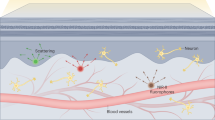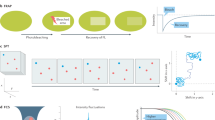Abstract
OBSERVATIONS on living organs excited by ultra-violet irradiations have been almost entirely confined to work on experimental animals. The specific fluorescence method was largely developed through the work of Ellinger and Hirt1,2, who termed it intravital fluorescence microscopy. The method found use in the investigation of resorptive and excretory functions of different organs, and offered valuable information about the physico-chemical conditions and processes in living cells, in particular the electrostatic phenomena. It also helped in the elucidation of various problems concerning the function of kidneys3,4, liver5,6, blood vessels7, and nerves8, and other organs of experimental animals.
This is a preview of subscription content, access via your institution
Access options
Subscribe to this journal
Receive 51 print issues and online access
$199.00 per year
only $3.90 per issue
Buy this article
- Purchase on Springer Link
- Instant access to full article PDF
Prices may be subject to local taxes which are calculated during checkout
Similar content being viewed by others
References
Ellinger, P., and Hirt, A., Z. Anat. Entwick., 90, 791 (1929).
Ellinger, P., and Hirt, A., in Handbuch der Biologischen Arbeits Methoden, edit. by Abderhalden, Abt V, Teil 2, p. 1753 (Urban and Schwarzenberg, Berlin and Vienna, 1930).
Singer, E., Arch. Pathol., 22, 813 (1963).
Metcalf, R. L., Arch. Biochem., 2, 55 (1943).
Hanzon, V., Acta Physiol. Scand., 28, Supp. 101 (1952).
Grafflin, A. L., Amer. J. Anat., 81, 63 (1947).
Teichman, K., Z. ges. ext. Med., 110, 732 (1942).
Tonutti, E., Schweiz. med. Woschschr., 76, 778 (1946).
Price, G. R., and Schwartz, S., in Physical Techniques in Biological Research, 3, p. 91 (Academic Press Inc., 1956).
Sherif, M., Acta Obstet. Gynec. Scand., 42 (1963).
Sherif, M., Acta Obstet. Gynec. Scand., 42 (1963).
Sherif, M., Diagnosis of Early Carcinoma of the Cervix by Simultaneous Application of the Fluorescence Cervicoscope and Vital Staining with Acridine Orange, A New Cancer Test (Univ. Cultural Press, 1963).
Bradley, D. F., and Wolf, M. K., Proc. U.S. Nat. Acad. Sci., 45, 944 (1959).
De Ment, J., Fluorochemistry (Chemical Press, Inc., Brooklyn, 1945).
Author information
Authors and Affiliations
Rights and permissions
About this article
Cite this article
SHERIF, M. Intravital Fluorescence Microscopy in the Qualitative Evaluation of the Interaction of Acridine Orange with Nucleic Acid in Intact Living Human Organs. Nature 204, 390–391 (1964). https://doi.org/10.1038/204390a0
Published:
Issue Date:
DOI: https://doi.org/10.1038/204390a0
This article is cited by
Comments
By submitting a comment you agree to abide by our Terms and Community Guidelines. If you find something abusive or that does not comply with our terms or guidelines please flag it as inappropriate.



